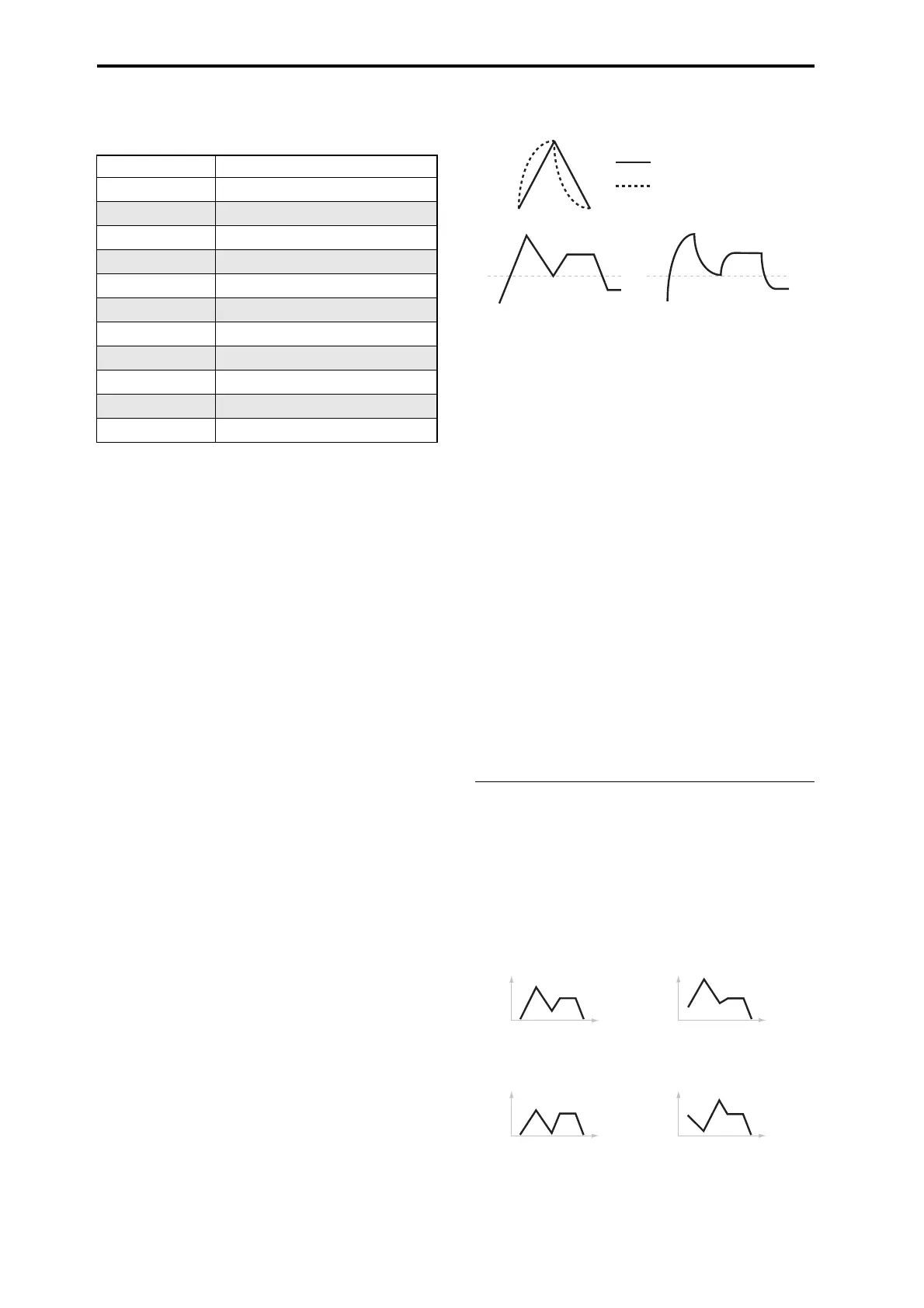PROGRAM mode: HD-1
80
Time
Higher values mean longer times, as shown below.
Attack [00…99]
This sets how long the EG takes to move from the Start level
to the Attack level.
The minimum attack time is 2/3 of a millisecond–as fast as
the most punchy of classic analog synths.
For the fastest possible attack time, you can set the Start
level to +99; in this case, the EG will start instantaneously at
its maximum value.
Decay [00…99]
This sets the time it takes to move from the Attack level to
the Break level.
Slope [00…99]
This sets how long the EG takes to move from the Break
level to the Sustain level. Once it reaches the Sustain level,
the EG will stay there until note-off (unless it is reset via
AMS).
Release [00…99]
This sets how long it takes the EG to move from the Sustain
level to silence.
Curve
For the sake of simplicity, most of the diagrams in this
manual show envelopes as being made out of straight lines.
In actuality, though, envelopes are more likely to be made
out of curves.
In other words, each segment’s level will change quickly at
first, and then slow down as it approaches the next point.
This tends to sound better than straight, linear segments.
Classic analog synth envelopes made these curved shapes
naturally. The NAUTILUS goes a step further than vintage
synths, however, and lets you control the amount of
curvature separately for each of the four envelope segments.
When you change the curvature, the EG times remain the
same. However, greater curvature will tend to sound faster,
because the value changes more quickly at the beginning.
Amp EG Curve
Different curve settings for up and down
You may find that different amounts of curvature are suitable
for segments which go up and segments which go down.
For instance, a curve of 3 is a good default setting for
upward segments, such as Attack. On the other hand, a curve
of 6 or more is good for downward segments, such as Decay
and Release.
Attack [0 (Linear), 1…9, 10 (Exp/Log)]
This sets the curvature of the Attack segment - the transition
from the Start level to the Attack level.
Decay [0 (Linear), 1…9, 10 (Exp/Log)]
This sets the curvature of the Decay segment - the transition
from the Attack level to the Break level.
Slope [0 (Linear), 1…9, 10 (Exp/Log)]
This sets the curvature of the Slope segment - the transition
from the Break level to the Sustain level.
Release [0 (Linear), 1…9, 10 (Exp/Log)]
This sets the curvature of the Release segment - the
transition from the Sustain level to the Release level.
4–3c: Level Modulation
These settings let you use any AMS source to control the
Level parameters of the EG. The Start, Attack, and Break
levels share a single AMS source, but can each have
different modulation intensities.
By using different settings for each of the three levels, you
can cause both subtle and dramatic changes to the EG shape,
as shown below.
Amp EG Level Modulation
EG Value Actual Time
00 0.667 ms
10 10 ms
20 44 ms
30 104 ms
40 224 ms
50 464 ms
60 944 ms
70 1.8 seconds
80 3.8 seconds
90 10.9 seconds
99 87.3 seconds
Curve = 0 (Linear)
Curve = 0 (Linear)
Curve = 10 (Exp/Log)
Curve = 10 (Exp/Log)
Original Shape
Positive AMS on Start and Break,
Negative AMS on Attack
Negative AMS on Start,
Attack, and Break
Volume
Time
Volume
Time
Volume
Time
Volume
Time
Positive AMS on Start,
Attack, and Break
